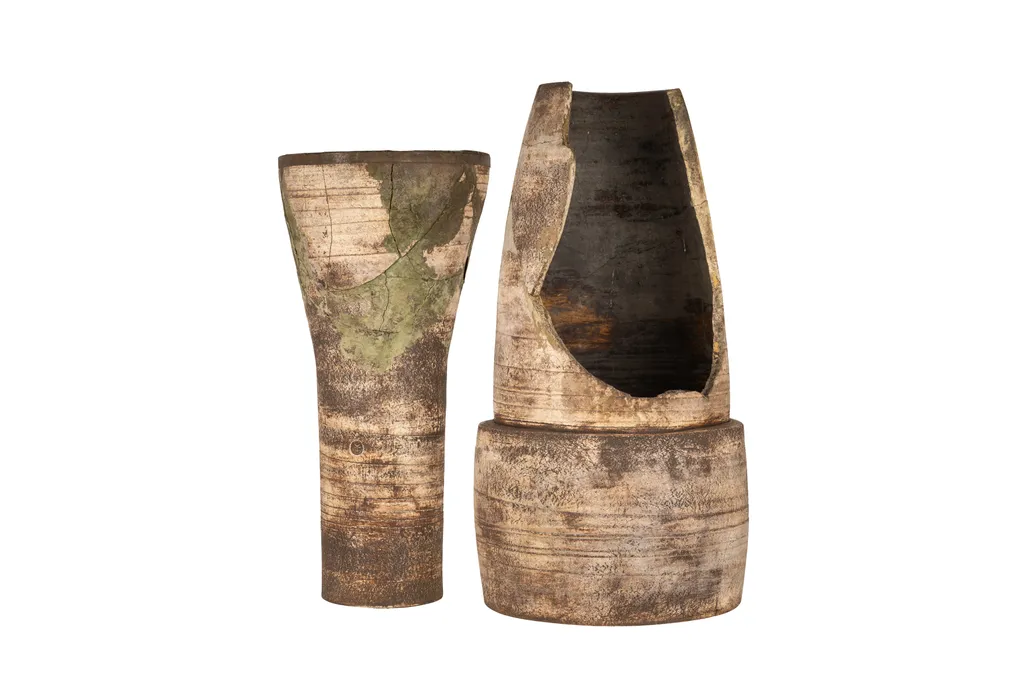Why Did This Broken Ceramic Pot Sell for More Than $60,000 at Auction?
Cool Finds
Why Did This Broken Ceramic Pot Sell for More Than $60,000 at Auction?
Discovered in pieces in a backyard garden in London, the vessel turned out to be the work of Hans Coper, one of Britain’s most influential potters
Even broken in two pieces, the rare pot shattered presale estimates.
Chiswick Aucitons
Finding a shattered ceramic pot in the backyard is not uncommon—unless the shards turn out to be the work of one of the 20th century's most significant ceramicists.
That unexpected discovery is exactly what happened to a group of grandchildren, who went to check on their grandmother’s London apartment after she died. In her garden, they stumbled upon a large ceramic pot that was broken into two pieces covered in snails and surrounded by weeds. But even in this state, the grandchildren, whose names have not been revealed, could tell that the pot was not just garden variety.
If put together, the two pieces of the pot would have stood at nearly four feet tall, and unlike typical pots, it was shaped with abstract flares and features. Since their grandmother moved in artistic circles, the grandchildren called an auction house in West London to assess the find.
“From afar you couldn’t tell what it was, especially as it was covered in weeds,” Jo Lloyd, a ceramic specialist at Chiswick Auctions who visited the pot in situ, tells the Times of London’s Laurence Sleator.
But upon closer inspection, Lloyd recognized the signature style and monographic seal of Hans Coper, a German-born British studio potter whose influential works mixed abstract form with functional elements.
The pot seen in its original form in 1964
Jane Coper / Chiswick Auctions
As it turned out, the woman who had the pot in her back garden had commissioned the work from Coper in 1964 after admiring his works at an exhibition. She had accidentally broken the pot, but instead of throwing it away, repurposed the two hunks as planters in her garden, per the Times.
Although the pot had seen better days, the auction house valued it between roughly $8,000 and $13,000. But the unique pot smashed presale estimates. At the auction last week, the Coper pot was the subject of a 10-minute bidding war between individuals in London, Denmark and New York, per Artnet’s Jo Lawson-Tancred. In the end, it sold for $63,250, including fees, to the bidder in the United States.
“Everyone is thrilled. The vendor didn’t expect the vessel to achieve its estimate so they are over the moon,” Maxine Winning, head of design at Chiswick Auctions, tells the Times. “The fact that you can sell a really damaged ceramic for that sort of price goes to prove how collectible and highly regarded Hans Coper is.”Coper was born into a middle-class Jewish family in Germany in 1920. His early life was marked by personal and political trauma, with his father’s suicide and the rise of Nazism forcing the teenager to flee to England in 1939, according to a statement from the auction house.
It was only after the war that Coper got his start in the art world. On a recommendation, Coper visited Lucie Rie, an Austrian-born potter who had also fled the Nazis and was known to hire other refugees. She started him on crafting ceramic buttons but recognized his talent and soon sent him to learn clay throwing from Heber Mathews.
Eventually, Rie and Coper began to make pottery collaboratively. Coper became increasingly interested in ancient pottery, applying black manganese to a style of white clay known as “T-Material” and sanding and scoring the vessel until it imitated something excavated from the ground.
That mottled texture is immediately apparent on the pot sold last week as well as other iconic works by Coper, such as the robust candlesticks he designed for Coventry Cathedral in England.
Hans Coper's identifying seal stamped into the clay vessel
Chiswick Aucitons
Coper’s ceramics have garnered great success, earning spots at museums like the Metropolitan Museum of Art in New York and the Victoria and Albert Museum in London, which calls him “arguably Britain’s most important post-war ceramic artist.”
While more than $60,000 may seem like a steep price for a broken vessel that requires an estimated $10,000 for restoration, per the Times, Coper’s works have fetched massive sums at auction. His seven highest-selling works have all sold for at least $500,000, according to Artnet, with the record set at nearly $900,000 for an ovoid pot in 2021.
The pot sold at auction last week is one of the tallest works Coper ever made, making it exceedingly unique in his illustrious oeuvre. For now, however, the vessel remains in two pieces. As Lloyd tells the Times, it “requires careful attention to restore it to its former glory.”
Get the latest stories in your inbox every weekday.


